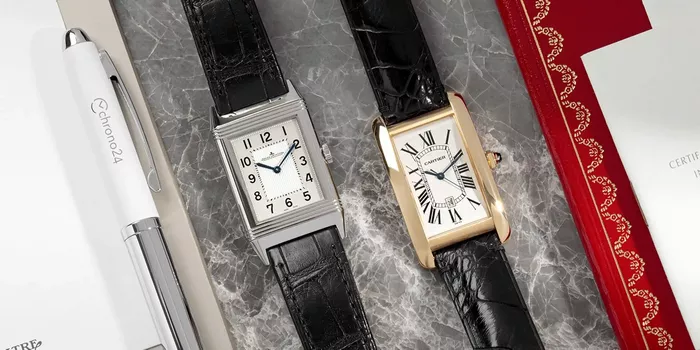In the realm of iconic watches, the Jaeger-LeCoultre Reverso and Cartier Tank stand as timeless symbols of elegance and craftsmanship. Both hailed as horological masterpieces, they have adorned the wrists of dignitaries and celebrities for decades. In this ultimate review, we explore the distinctive features, histories, and legacies of the Jaeger-LeCoultre Reverso and Cartier Tank, helping you navigate the choice between these two iconic timepieces.
1. Jaeger-LeCoultre Reverso: A Timeless Flip
History and Innovation:
Art Deco Origins: The Jaeger-LeCoultre Reverso was born in the Art Deco era of the 1930s. Originally designed for polo players seeking a durable watch, its defining feature is the reversible case, allowing wearers to protect the delicate dial by flipping it over.
Versatility and Customization: Beyond its functional design, the Reverso has evolved into a canvas for artistic expression. From personalized engravings to intricate dials, the ability to customize a Reverso adds a layer of individuality to this horological icon.
2. Cartier Tank: Elegance in Geometry
Timeless Design and Heritage:
Inspiration from Tanks: The Cartier Tank draws inspiration from the linear and geometric shapes of military tanks during World War I. Introduced in 1917, the watch’s rectangular case and Roman numeral dial epitomize the fusion of elegance and utility.
Cultural Significance: The Tank has been adorned by cultural icons like Jackie Kennedy and Andy Warhol. Its enduring design has transcended time, making it a symbol of understated luxury.
3. Design Aesthetics and Materials
Jaeger-LeCoultre Reverso:
Reversible Case: The hallmark feature of the Reverso is its reversible case. This practical design has not only preserved the watch’s delicate dial but has also become an emblem of style and sophistication.
Materials and Finishing: Crafted in various materials, including stainless steel, rose gold, and platinum, the Reverso offers a range of options for different tastes. The meticulous finishing and attention to detail underscore Jaeger-LeCoultre’s commitment to excellence.
Cartier Tank:
Distinctive Rectangular Case: The Tank’s rectangular case is a defining element of its design. Crafted in materials like gold and steel, the Tank exudes a sense of refinement. The beaded crown, inspired by tank treads, adds a subtle touch of sophistication.
Dial Design: The Tank’s dial features classic Roman numerals, blue sword-shaped hands, and a chemin de fer chapter ring, creating a harmonious and legible composition.
4. Movement and Horological Prowess
Jaeger-LeCoultre Reverso:
In-House Movements: Jaeger-LeCoultre is renowned for its in-house movements, and the Reverso is no exception. From manual-winding to automatic movements, the Reverso combines form and function seamlessly.
Complications: The Reverso collection includes models with various complications, such as tourbillons and dual time zones, showcasing Jaeger-LeCoultre’s technical prowess.
Cartier Tank:
Reliable Movements: While Cartier has historically used movements from renowned Swiss manufacturers, recent Tank models often feature in-house movements, demonstrating the brand’s commitment to horological excellence.
Variety of Models: The Tank collection offers a variety of models, from simple time-only versions to more complex models with additional complications like skeletonized movements.
5. Wearability and Versatility
Jaeger-LeCoultre Reverso:
Versatile Elegance: The Reverso’s ability to transform from a classic timepiece to a personalized piece of art adds a layer of versatility. Its slim profile and comfortable fit make it suitable for various occasions.
Sporty and Dressy Options: Whether you choose a sporty Squadra model or a classic Grande Reverso, the Reverso caters to diverse tastes, making it an ideal companion for both casual and formal settings.
Cartier Tank:
Understated Luxury: The Tank’s refined design and moderate size make it a versatile choice for everyday wear. Its discreet elegance allows it to seamlessly transition from day to night.
Bracelet and Strap Options: The Tank is available with different bracelet and strap options, allowing wearers to customize their timepiece for comfort and style.
FAQs on Jaeger-LeCoultre Reverso vs. Cartier Tank
1. Which watch is more suitable for formal occasions?
Both the Jaeger-LeCoultre Reverso and Cartier Tank are well-suited for formal occasions due to their timeless designs and understated elegance. The choice ultimately depends on personal preference.
2. Can I swim with the Reverso or Tank?
While both watches are water-resistant to some extent, it’s advisable to avoid swimming with them, especially if they have leather straps. Water-resistant ratings can vary, so it’s crucial to check the specific model’s specifications.
3. Are these watches suitable for women?
Yes, both the Reverso and Tank offer models that are suitable for women. The smaller sizes and elegant designs make them popular choices among female watch enthusiasts.
4. Do these watches hold their value over time?
Both Jaeger-LeCoultre and Cartier are respected luxury watch brands, and their iconic models tend to hold their value well, especially if properly maintained. However, the resale value can be influenced by factors such as rarity, condition, and market demand.
5. Can I find vintage models of the Reverso and Tank?
Yes, vintage models of both the Reverso and Tank are available in the market. Collectors and enthusiasts often seek vintage pieces for their historical significance and unique charm.
6. Are there specific models recommended for a first-time luxury watch buyer?
For first-time buyers, the Jaeger-LeCoultre Reverso and Cartier Tank both offer entry-level models that capture the essence of each collection. Consider factors such as design preferences, size, and budget when making a decision.
Conclusion: In the realm of horology, the Jaeger-LeCoultre Reverso and Cartier Tank stand as benchmarks of timeless design and craftsmanship. Whether you’re drawn to the Reverso’s reversible case or the Tank’s geometric elegance, both watches offer a blend of history, artistry, and functionality. The choice between them ultimately boils down to personal taste and the unique story each watch tells on your wrist.

